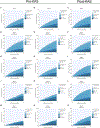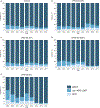How do highly sensitized patients get kidney transplants in the United States? Trends over the last decade
- PMID: 32065704
- PMCID: PMC8717833
- DOI: 10.1111/ajt.15825
How do highly sensitized patients get kidney transplants in the United States? Trends over the last decade
Abstract
Prioritization of highly sensitized (HS) candidates under the kidney allocation system (KAS) and growth of large, multicenter kidney-paired donation (KPD) clearinghouses have broadened the transplant modalities available to HS candidates. To quantify temporal trends in utilization of these modalities, we used SRTR data from 2009 to 2017 to study 39 907 adult HS (cPRA ≥ 80%) waitlisted candidates and 19 003 recipients. We used competing risks regression to quantify temporal trends in likelihood of DDKT, KPD, and non-KPD LDKT for HS candidates (Era 1: January 1, 2009-December 31, 2011; Era 2: January 1, 2012-December 3, 2014; Era 3: December 4, 2014-December 31, 2017). Although the likelihood of DDKT and KPD increased over time for all HS candidates (adjusted subhazard ratio [aSHR] Era 3 vs 1 for DDKT: 1.74 1.851.97 , P < .001 and for KPD: 1.70 2.202.84 , P < .001), the likelihood of non-KPD LDKT decreased (aSHR: 0.69 0.820.97 , P = .02). However, these changes affected HS recipients differently based on cPRA. Among recipients, more cPRA 98%-99.9% and 99.9%+ recipients underwent DDKT (96.2% in Era 3% vs 59.1% in Era 1 for cPRA 99.9%+), whereas fewer underwent non-KPD LDKT (1.9% vs 30.9%) or KPD (2.0% vs 10.0%). Although KAS increased DDKT likelihood for the most HS candidates, it also decreased the use of non-KPD LDKT to transplant cPRA 98%+ candidates.
Keywords: clinical research/practice; donors and donation: deceased; donors and donation: paired exchange; health services and outcomes research; kidney transplantation/nephrology; panel reactive antibody (PRA); registry/registry analysis.
© 2020 The American Society of Transplantation and the American Society of Transplant Surgeons.
Conflict of interest statement
DISCLOSURE
The authors of this manuscript have no conflicts of interest to disclose as described by the
Figures


References
-
- Jordan SC, Choi J, Vo A. Kidney transplantation in highly sensitized patients. Br Med Bull. 2015;114(1):113–125. - PubMed
-
- Bostock IC, Alberú J, Arvizu A, et al. Probability of deceased donor kidney transplantation based on % PRA. Transpl Immunol. 2013;28(4):154–158. - PubMed
-
- Wallis CB, Samy KP, Roth AE, Rees MA. Kidney paired donation. Nephrol Dial Transplant. 2011;26(7):2091–2099. - PubMed
Publication types
MeSH terms
Grants and funding
- K23DK115908/DK/NIDDK NIH HHS/United States
- F32 DK117563/DK/NIDDK NIH HHS/United States
- F32DK117563/DK/NIDDK NIH HHS/United States
- K01 DK101677/DK/NIDDK NIH HHS/United States
- F32DK113719/DK/NIDDK NIH HHS/United States
- K24 AI144954/AI/NIAID NIH HHS/United States
- K23 DK115908/DK/NIDDK NIH HHS/United States
- K01DK101677/DK/NIDDK NIH HHS/United States
- K24 DK101828/DK/NIDDK NIH HHS/United States
- T32 HL007055/HL/NHLBI NIH HHS/United States
- K24DK101828/DK/NIDDK NIH HHS/United States
- F32 DK113719/DK/NIDDK NIH HHS/United States
LinkOut - more resources
Full Text Sources
Medical
Research Materials

